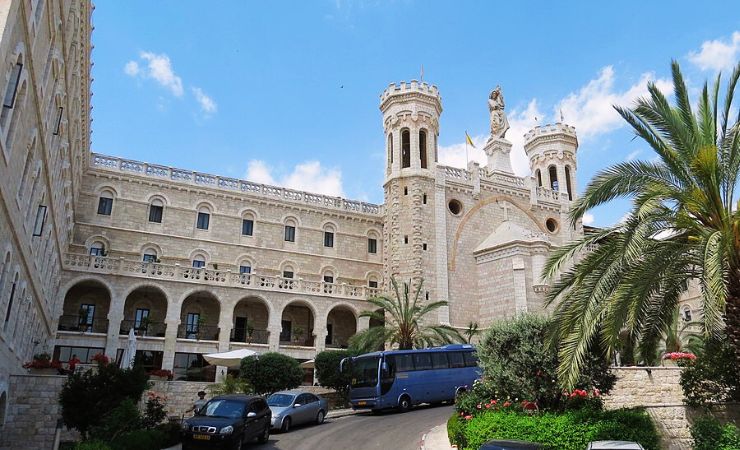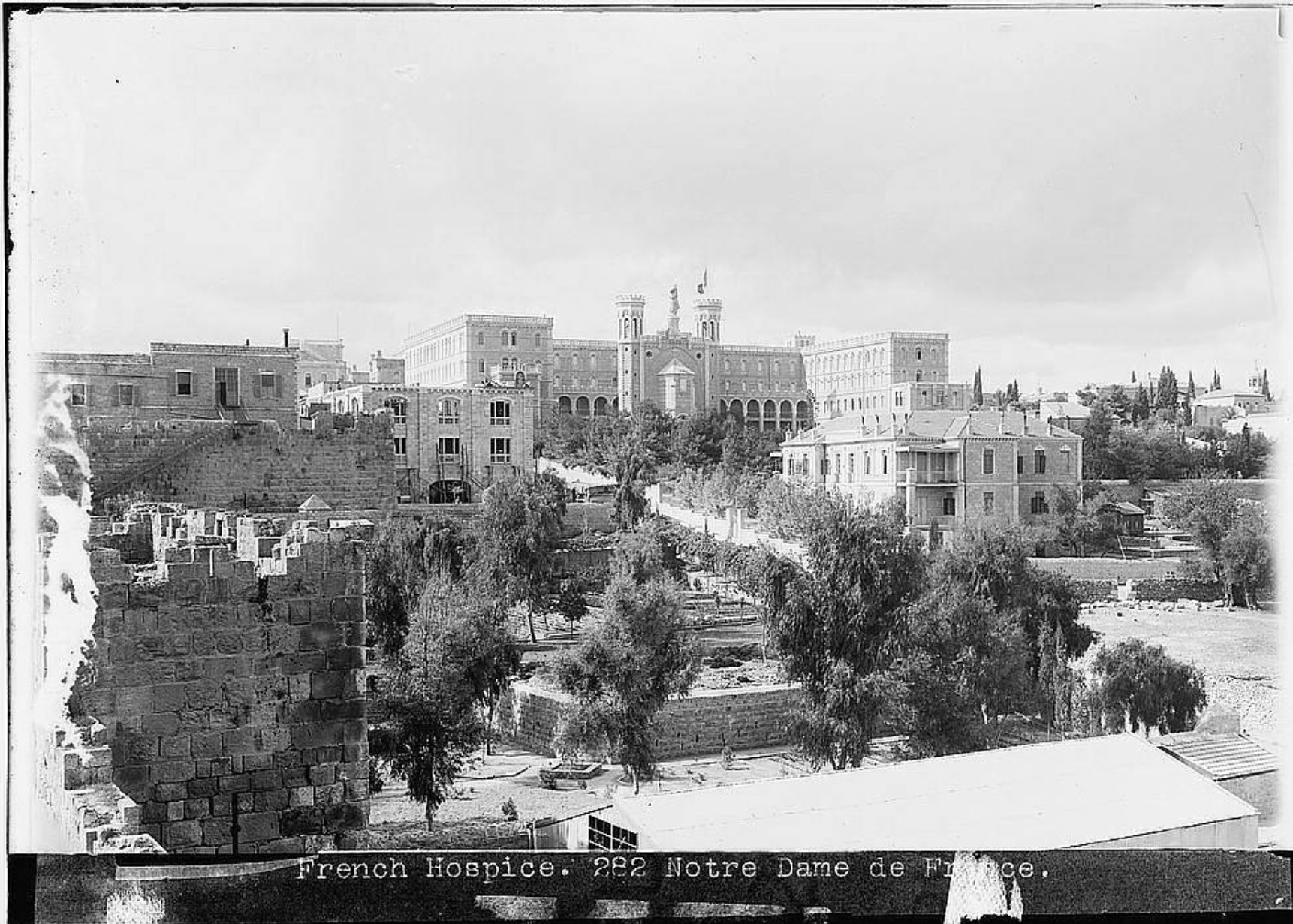Notre Dame Compound: A Sanctuary of History and Hospitality in Jerusalem
The Notre Dame French Compound is a stunning grand complex with beautiful architecture and serene atmosphere located just outside the ancient walls of Jerusalem’s Old City.

Location
The Notre Dame French Compound is strategically located adjacent to the New Gate of Jerusalem’s Old City. This prime location places it within walking distance of some of the most significant religious and historical sites in the world.
Historical Context
The Notre Dame French Compound was established in the late 19th century, a period marked by increased European interest in the Holy Land. The complex was conceived by the Assumptionist Fathers and constructed between 1884 and 1904 to accommodate the influx of French pilgrims traveling to Jerusalem. The original purpose of the compound was to provide a safe and comfortable place for these pilgrims to stay while visiting the holy sites.
Over the years, the compound has witnessed numerous historical events. During World War I, it was used as a military hospital, and in the turbulent years that followed, it served various functions under different administrations. In the late 20th century, the Vatican acquired the property, further solidifying its role as a center for pilgrimage and hospitality.




Architectural Features
The Notre Dame French Compound is a splendid example of neo-Romanesque architecture, characterized by its robust and majestic structure. The building’s facade is adorned with intricate carvings and statues, reflecting its religious significance and artistic heritage. Here are some of the key architectural features of the compound:
- Grand Facade: The main entrance is a striking sight with its towering arches and detailed stonework, immediately conveying a sense of grandeur and reverence.
- Stained Glass Windows: Throughout the chapel and other key areas, you’ll find beautifully crafted stained glass windows that depict various biblical scenes and saints. These windows add a vibrant array of colors to the interior, especially when illuminated by sunlight.
- High Vaulted Ceilings: The chapel and main halls feature soaring vaulted ceilings that create a spacious and airy atmosphere, enhancing the spiritual ambiance.
- Bell Towers: The twin bell towers are a notable feature, rising high above the compound and offering stunning views of Jerusalem. These towers are not only architectural marvels but also serve as landmarks visible from various points in the city.
- Courtyards and Gardens: The inner courtyards and gardens provide a serene contrast to the imposing stone structures. These green spaces are meticulously maintained and offer peaceful retreats for reflection and relaxation.
- Cloisters: The cloistered walkways, lined with arches and columns, add to the historical charm and provide shaded areas for contemplation and leisure.
What Can Be Found at the Notre Dame French Compound
Visitors to the Notre Dame French Compound can explore a variety of attractions and amenities:
- The Chapel: A place of worship and reflection, featuring stunning religious art and architecture.
- Accommodation Facilities: The compound offers a range of comfortable rooms, blending historic charm with modern conveniences, catering to pilgrims and tourists alike.
- Restaurants and Cafes: Guests can enjoy a variety of dining options, including traditional French cuisine and local delicacies, in the compound’s elegant restaurants and cozy cafes.
- Museum of the Shroud of Turin: This fascinating museum features exhibits related to the Shroud of Turin, offering insights into its history and significance. Read more about the museum and shrouds below.
- Panoramic Rooftop Terrace: Offering breathtaking views of Jerusalem’s Old City, the rooftop terrace is a perfect spot for relaxation and photography.
- Conference Halls and Event Spaces: The compound is equipped with modern facilities for conferences, seminars, and other events, making it a versatile venue for various gatherings.
Jesus Shroud Exhibition
One of the most intriguing aspects of the Notre Dame French Compound is the Museum of the Shroud of Turin. This exhibition delves into the mysteries and history surrounding the Shroud of Turin, believed by many to be the burial cloth of Jesus Christ.
The Shroud of Turin: An Overview
The Shroud of Turin is a length of linen cloth bearing the negative image of a man who appears to have suffered physical trauma in a manner consistent with crucifixion.
Many believe this to be the burial cloth of Jesus Christ, although its authenticity has been a topic of debate for centuries. The Shroud is currently housed in the Cathedral of Saint John the Baptist in Turin, Italy, but the Museum of the Shroud of Turin in the Notre Dame French Compound provides a detailed replica and comprehensive exploration of this enigmatic artifact.
Exhibition Highlights
Detailed Replica: At the heart of the museum is a life-sized replica of the Shroud. This allows visitors to closely examine the intricate details and markings that have fascinated scholars and believers alike. The replica is displayed in a carefully controlled environment to preserve its features.
Historical Journey: The museum provides a timeline of the Shroud’s history, tracing its journey from Jerusalem to Turin. This section includes information about its discovery, various historical mentions, and the scientific studies conducted over the years.
Scientific Investigations: A significant portion of the exhibition is dedicated to the scientific studies conducted on the Shroud. This includes radiocarbon dating, forensic analysis, and botanical research. Interactive displays explain these complex investigations in an accessible manner, allowing visitors to understand the various perspectives on the Shroud’s authenticity.
Religious and Cultural Significance: The exhibition delves into the Shroud’s profound impact on Christian devotion and its role in religious art and culture. Various religious artifacts and artworks inspired by the Shroud are displayed, illustrating its influence over centuries.
Interactive Displays: Modern technology enhances the museum experience with interactive displays that allow visitors to explore the Shroud in greater detail. Touchscreens and multimedia presentations provide in-depth information and engage visitors in the ongoing debate about the Shroud’s origins.
Nearby Sites
- Tancred’s Tower: An important Crusader-era fortification, this tower offers a glimpse into the medieval history of Jerusalem and provides panoramic views of the city.
- Damascus Gate: One of the main entrances to the Old City, Damascus Gate is a bustling hub of activity and a gateway to the vibrant markets and historical sites within.
- Garden Tomb: Believed by some to be the site of Jesus’ burial and resurrection, the Garden Tomb is a peaceful and contemplative space, offering an alternative to the Church of the Holy Sepulchre.
- Jaffa Gate: Another prominent entrance to the Old City, Jaffa Gate is surrounded by historical landmarks and offers easy access to the Armenian and Christian Quarters.
- Mamilla Pool: An ancient reservoir dating back to the Second Temple period, Mamilla Pool is an archaeological treasure that sheds light on Jerusalem’s ancient water management systems.



